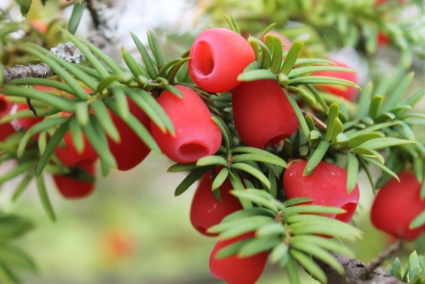While many plants have now shed their leaves or retreated underground until the spring returns there are some plants which are looking at their best during this time of year.
We have several European yew trees which really are at their best in winter, this is the time of year when conifers really come into their own!
The latin name for yew is Taxus baccata. This name gives a hint as to the characteristics of the tree, with the genus name Taxus meaning ‘toxic’ and the species name baccata meaning ‘bearing red berries’.
Unlike many other conifers which bear their seeds in cones the yew produces seeds individually on branch tips, which each seed surrounded by a red fleshy ‘berry’. Though if we really wanted to get technical the fruits present on the yew are not, in fact, berries. The red flesh around the seed is an aril, with the fleshy outgrowth being derived from the ‘stalk’ (or funicle to give its correct name!) on which the seed is held inside the ovary, rather than being derived from the ovary wall itself, as in a true ‘berry’…..anyway, I digress….ignore my fruit related musings and check out the photo below!
Above: the attractive fleshy aril of the yew.
Every part of the plant is toxic except for the red flesh covering the seed, which is edible but pretty tasteless so I’m told. How toxic you ask? well the plant contains the chemical Taxine, which is a highly toxic alkaloid linked to the inhibition of heart depolarisation. In short, it stops the heart from beating. It’s thought that ingesting just a couple of seeds will kill a person in a matter of minutes….not sure I’ll be tasting those fruits after all!

The seeds pass unscathed through the digestive tract without any problem – a clever adaptation, as the yew doesn’t kill the animal that’s helping propagate it – although it’s probably best not to try to verify this by personal experiment. The fruits aren’t very tasty, but quite sweet and sickly, and a rather unpleasant texture. An old country name for the seeds is snotty-gobble, and if you squeeze a fruit between your finger and thumb you will see why.